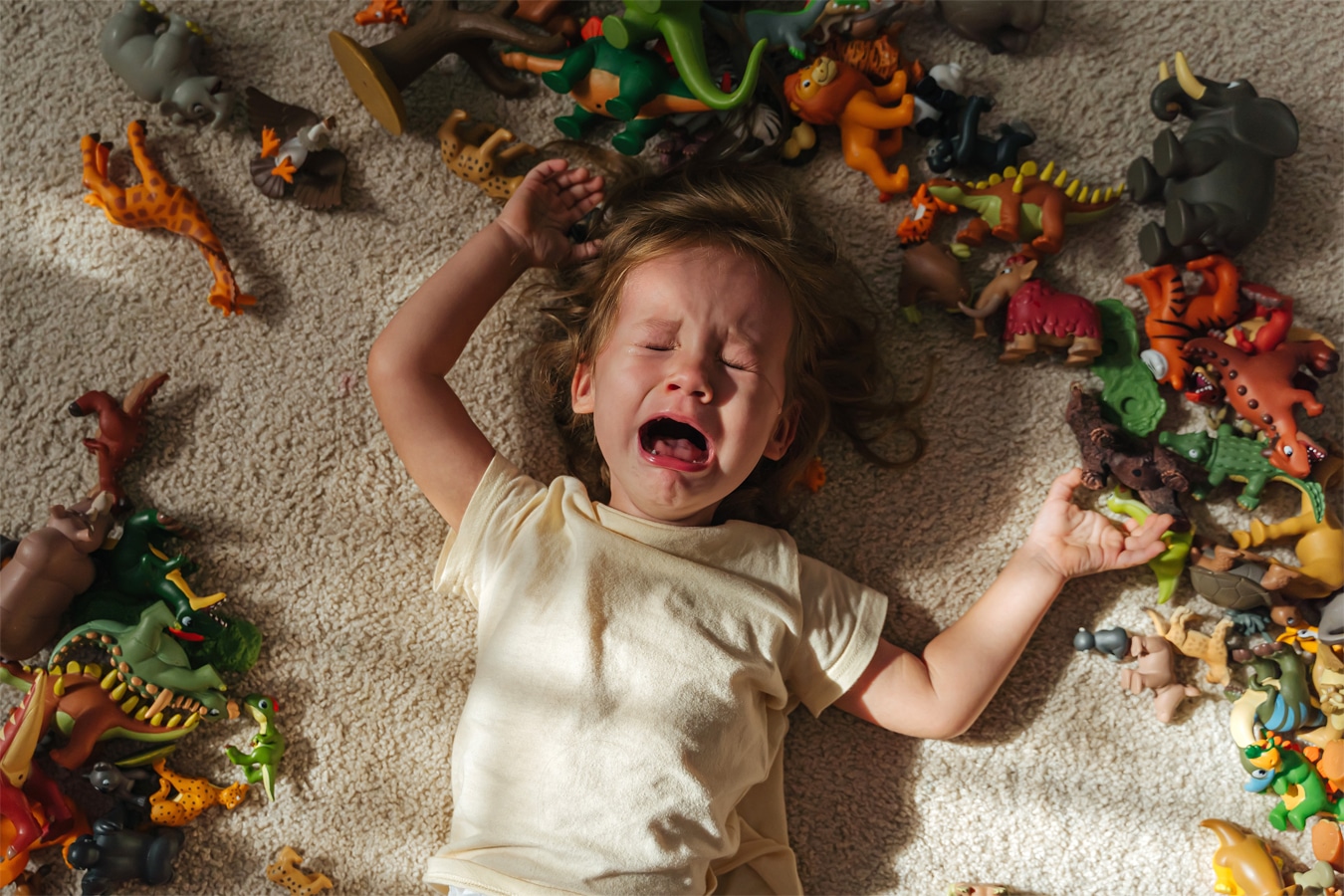In the moment, you’re not quite sure what to do when deal with a child’s tantrum. Remember these three steps.
You’ve spent the last three hours wrangling your kids into bed, and just as you’re nearing the finish line, your toddler throws himself onto the floor, wailing because he wanted to take his socks off.

In an instant, that familiar wave of frustration surges through your body. All you want is an off switch—anything to make the madness stop so you can finally have a moment of peace.
So, you reach for the usual tools.
- You take a deep breath, hoping to calm the storm inside.
- You try naming your toddler’s feelings, thinking it might diffuse the meltdown.
- And, like any desperate parent, you might even resort to bribes and threats.
But no matter what you do, it only seems to make things worse.
Here’s the hard truth: when life with kids feels chaotic, you can’t control your toddler’s emotions.
The good news? You can control how you experience and respond to their big feelings. By shifting your approach, you’ll not only feel calmer in the moment but also become the steady guide your child needs.
Here’s how.
1. Regulate Your Own Emotions
The first step to taming your toddler’s tantrum begins with you.
When your child is in the throes of a meltdown, it’s natural to feel frustrated, anxious, or even helpless.
But if you’re dysregulated, you can’t show up for your child in the way they need.
Because your toddler relies on you to help them co-regulate. So if you’re reacting out of frustration or panic, you’re not only unable to guide them, but you’re also leaving them to navigate their overwhelming feelings alone—a task far beyond their young abilities.
So when you feel the familiar impulse to jump in and make it all better, take a moment, and let yourself know: I’m dysregulated.
But don’t let the thought just pass you by. Instead, take a few moments to look for, and observe, the signs.
Notice your clenched jaw.
Your tense shoulders.
That powerful urge to explode.
And most of all, don’t try to make it go away!
Instead, speak to yourself with compassion and understanding.
Of course you’re dysregulated! You’re exhausted, and just want to get the kids to sleep, and now you have to deal with another tantrum.
As long as you, and your kid aren’t in any danger, take your time and don’t rush this step (even though you’re itching to get the kids to bed already!)
Your dysregulation is real, it matters and it deserves attention.
And what’s more is that when you feel more grounded, you’ll be better equipped for step 2.

2. Step Into Your Child’s World
Once you’ve tapped into the discomfort of your inner chaos with compassion and understanding, you can shift your focus to your toddler.
Instead of trying to fix or stop the tantrum, step into their shoes with a sense of validation.
Pretend you’re them, and narrate their experience.
“I hate it when mom takes off my socks. I wanted to take off my sock! “
But remember, this is about joining your child in their emotional state, not teaching them what they’re feeling.
So even if you don’t fully understand their emotions, and in your adult mind, it all seems absurd and unnecessary, your job is to let your kid know that you get it.
While this approach can feel counterintuitive, especially when every fiber of your being wants to “fix” the tantrum, it’s one of the most powerful ways to help your child feel safe and understood.
3. Be Their Guide Through the Chaos
Once your toddler starts to sense that you’re with them, it’s time to gently guide them out of the emotional forest.
Think of yourself as their coach—someone who isn’t trying to stop their feelings but is showing them the way back to calm.
Your goal isn’t to end the tantrum but to model the process of moving from chaos to control.
For this to work, you need to truly believe that you and your child can move through these big emotions, because they’ll sense your confidence and trust in the process, which helps them feel secure.
If this feels like a daunting task, you’re not alone. Guiding a child through their emotions requires practice, patience, and the belief that calm is possible—for both of you.
So be patient with yourself, and your kiddo, and remember that you can’t control your kid, but you can control how you relate to them, and that begins with how you relate to yourself.
Control how you experience and respond. By shifting your approach, you’ll feel calmer in the moment & become the steady guide your child needs




I don’t understand you outlined what to do in steps 1 and 2 but not in 3 what does that look likie?
Hey Riki,
Here step 3
Once your toddler starts to sense that you’re with them, it’s time to gently guide them out of the emotional forest.
Think of yourself as their coach—someone who isn’t trying to stop their feelings but is showing them the way back to calm.
There’s more above, but if you need a more personalized response, let me know.
yes, was wondering the same. what’s the practical application for step 3?
Hey Tziri,
Okay, I get it. The question is What do I actually do! So it really depends on what’s happening. But whatever it is, say you want your kid to sit at the table, or they’re freaking out because you peeled their banana, the key is to first and foremost regulate. You’ll know you’re regulated because 1. you won’t “care” that you’re kid is freaking out. 2. You’ll be able to see the situation from their point of view. So much so, you could narrate it on their behalf. “I’m so mad that Mommy peeled my bananan! Didn’t she know that I wanted to do it!” See what happens when you say it outloud. The point isn’t to make your kid calm!! The point is to let them know that they’re experience is real, and that they’re not alone. The third step is to lay down the fact. You peeled the banana. If it’s available, you might decide to offer your kid an unpeeled banana. But if that’s the last banana, well, sorry buddy, this is what it is. Tantrums are tough for us, as much as they are for our kiddos because they are starting to experience the limitation of reality. Sometimes there’s only one banana and the chance to peel it is taken away. Sometimes your favourite dress gets stained and has to be turned to rags, Sometimes, you get a flar tire when you’re running late. It’s life and as a parent, it’s our job to help our kids build the emotional resilience to tolerate and engage with reality, even when it doesn’t go our way. I hope that answers your question. Please let me know if you need more clarification. <3 Liba
Hey Riki,
I just left a more detailed comment for Tziri below. You might want to give it a read. I think it might be more of what you’re looking for. If not, let me know. I’m here to help <3 Liba
got it!!! thanks!! i appreciate it!!
This reminds me of a story I once heard:
There was a women in a grocery store shopping with her toddler. Her toddler was having a complete meltdown and the mother just kept saying “Devoiry, it’s going to be okay. Devoiry, we will be leaving very soon…”
By checkout, the cashier looked at the mother and said “oh wow, what a cute little girl! Her name is Devoiry- right?” And the mother just laughed and said “No, I am Devoiry, that’s my name”
This was her way of calming herself down, coping and being a guide for her daughter.